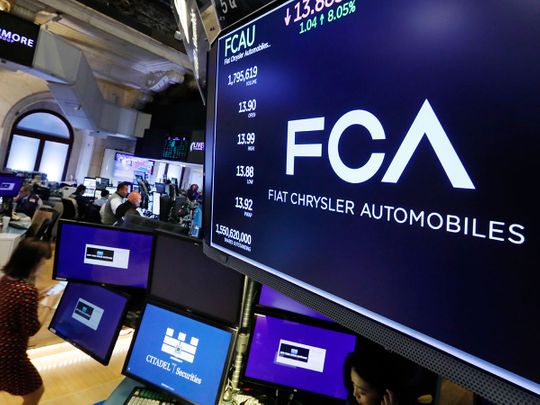
When the US auto industry was looking down a barrel in 2008, General Motors Co. did the unthinkable and quietly proposed a merger with cross-town rival Ford Motor Co.
It didn’t happen — GM ended up filing for Chapter 11, while Ford managed to avoid a bailout. But the fact they even broached the matter spoke volumes about the pressures those rivals were under.
Now Europe’s auto industry has its own pause-and-gasp-for-breath equivalent. On Monday, Fiat Chrysler Automobiles NV said it hopes to merge with Renault SA to form the world’s third-largest carmaker (or by far the largest if you include Renault’s alliance partner Nissan, which arguably one should).
There are attractions in collaboration, but this merger proposal goes well beyond a more limited alliance or partnership. So why is Fiat’s billionaire chairman John Elkann taking such a big risk?
Unlike their US counterparts in 2008, neither Fiat nor Renault is loss-making or facing imminent collapse. But both face painful industry upheaval: car sales are slowing, just as the costs of developing electric vehicles and of complying with ever-stricter emissions targets are surging. Fiat thinks the answer is to achieve huge scale and thereby share the financial burden in meeting those challenges. Is it?
Due to its limited financial resources, Fiat is a laggard in electric vehicles while Renault is an acknowledged leader. But thanks to its acquired Jeep and Ram brands, Fiat has a very profitable truck and SUV business in the US. By contrast, Fiat’s European operations are hardly profitable, which may explain why it picked Renault as a potential merger partner over Peugeot SA, whose sales are more heavily skewed towards Europe.
Then there are the cost and investment savings, which Fiat estimates could total 5 billion euros annually. There are reasons to be sceptical about that figure. No factory closures are planned, which is typically one of the quickest and most painful ways to slash expenses. Instead, the savings are expected to come from common purchasing, shared vehicle platforms and R&D. Factoring the lengthy timespan the synergies will take to achieve, plus integration costs, and that headline figure might be worth only about 3.5 billion euros of value creation to each side, by my rough calculations.
Before today, both companies were valued at just 4 times estimated earnings, poor even by the standards of the auto industry. Doubtless, the merged entity would hope to enjoy a stock market re-rating which might improve the financial benefits of a deal to about 5 billion euros for each side.
For all that promise, Fiat and Renault each gained only about 2 billion euros of market value on Monday. That discount doubtless reflects the risk that the deal may not happen or deliver the promised benefits.
Merging the two companies would create huge complexity and governance risks that the promised large slate of independent board members might still struggle to alleviate.
Neither side was likely to countenance being the junior partner in a tie-up. It’s fortunate, then, that Fiat and Renault’s market capitalisation weren’t all far apart, so a merger of equals is possible, at least on paper. The slight valuation disparity would be offset by a cash payment to Fiat shareholders.
But mergers of equals rarely work, and automotive M&A especially has a poor track record. Fiat’s acquisition of Chrysler was a success, but Daimler’s earlier acquisition of Chrysler was a disaster.
It’s odd that Fiat has pitched a merger while Renault is in a tussle with its alliance partner Nissan. Perhaps the Japanese will view this as a helpful distraction that will stop Renault’s managers trying to deepen their alliance for the time being. A merger with Fiat would also dilute the influence of the French state, which currently holds 15 per cent of Renault’s shares and even more of the voting rights.
However, it’s also possible Nissan will see this is an attempt to swing the weight of the Renault-Nissan alliance even more toward Europe. As with the alliance, politics presents a huge challenge to this merger. Expect France and Italian interests to battle for every cent of investment spending. If job cuts become a necessity, things could get even more tense.
But politics also explains why this deal is even being discussed. By demonising diesel vehicles while clamping down on carbon emissions, governments have backed carmakers into a corner. As in 2008, this is what happens when an industry gets desperate.












